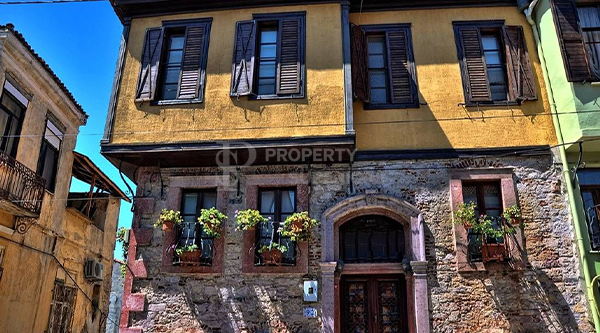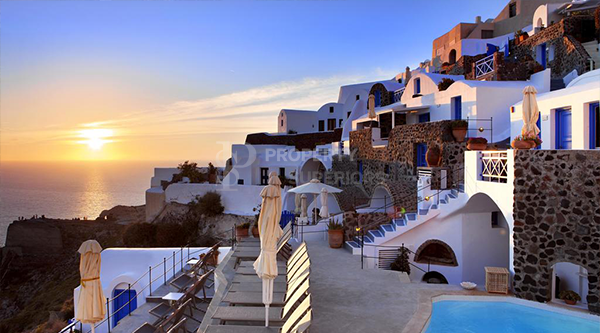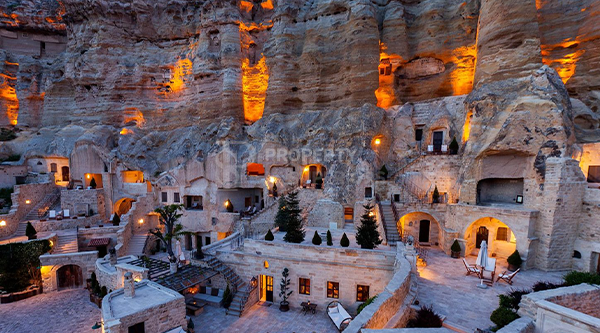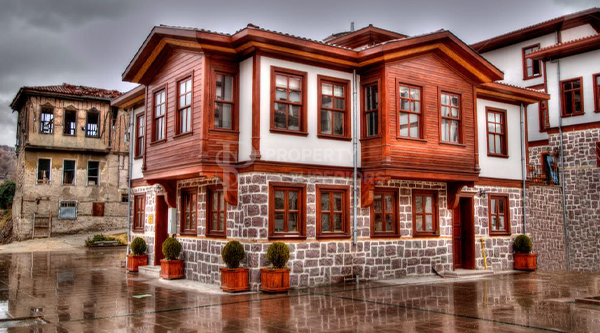
When looking at traditional Turkish houses, don't be one size fits all, as there is more than one style of architecture. While some parts of Turkey are better known than others for their iconic housing markets, each region has a different flavor of Turkey for a number of reasons. Previously, local Turkish people used local resources to build their houses. For example, a breathtaking story is the ancient ruins of Geyre and Aphrodisias. One day, while traveling in this village, a historian noticed ancient stone pillars on the walls of houses.
He asked the villagers where they got these stones, and they told him about an ancient undiscovered city called Aphrodisias! Unaware of the importance of this ancient Turkish city, the locals took the fallen columns and pillars to build family homes. Also, Turkey is a vast country with several different climate zones, so locals always build their houses to withstand the Turkish weather conditions. Exploring traditional houses in Turkey can give you an insight into Turkish culture and traditions of bygone eras. Let's see where to start exploring.
7 styles of traditional Turkish houses
1: Ottoman houses in Safranbolu
The Turkish city of Safranbolu has been granted UNESCO World Heritage status for its ancient Ottoman houses that represent a major trading post and center of bustling Ottoman life. The houses are easy to spot thanks to stone floors and wooden upper floors. In the past, all Ottoman houses were built of wood; however, this proved to be a fire hazard; thus, architectural styles in Turkey changed. Traditional Ottoman houses often use the lower floors as storage areas for animals or crops. The upper floor contains various rooms organized around a large open space and the living room, which functions as bedrooms at night. Lots of windows also let in plenty of natural light. Other places in Turkey where old Ottoman houses can be seen are Amasya and Beypazari.
2: Yayla Chalet at Mount Kaka
Traveling to the highlands of northeastern Türkiye, the way of life changes completely. Here the Turkish natives live among the miles of forest, so they build their houses out of wood. However, there are two points worth noting. First, the ground floor has remained unoccupied for two reasons. First of all, it is not uncommon for wild animals to go down the mountain for food in winter. In addition, the region is the main producer of Turkish honey that carries love! Second, they would graze their cattle on the lower floors at night, and the heat would rise, keeping them warm on the second floor. So if you are spending your Turkish holidays in Uzungol or Ayder plateau, stay in an authentic wooden hotel.
3: Aegean and Mediterranean stone houses in Türkiye
Perhaps the most famous stone house place is Kayakoy in the Fethiye region of Türkiye. However, the style appeared throughout the south and along the Mediterranean coast. Usually, these houses have only one or two floors. The entrance leads to a courtyard, which is often used in summer due to the extreme heat of the day and night. In order to meet the current construction and housing needs, many old stone houses were renovated and bought, thus selling high in the Turkish real estate market. These houses are sometimes called Greek cottages. This is so because before the collapse of the Ottoman Empire, many Greek communities inhabited Turkey's Mediterranean and Aegean coasts, leaving their cultural imprint through their way of life. (See an example of a renovated stone house in Kayakoy.)

4: Whitewashed Turkish houses in Bodrum
Head to Turkey's Aegean coast, where the Bodrum peninsula is famous for the white houses that adorn the hills. Commonly known as sugar cube houses, they are very similar in floor plan to stone houses, but are painted white and have blue shutters and doors. Blue repels scorpions and other insects, and white reflects summer heat. As in a stone house, life is centered around the courtyard, which is the hive of summer activity. In general, these houses serve one main purpose; to keep them cool in summer and warm in winter.
5: Traditional cave dwellings in Cappadocia
Here, traditional ways of life arouse interest. The central region of Cappadocia is famous for its Turkish cave houses, as the tuff rock that covers the landscape is soft enough to be carved, yet durable enough to survive both summer and winter. Many older homes are in Turkish conservation, and if you buy it and renovate it, you will reap a handsome return. However, this makes cave houses one of the fastest growing housing markets in Turkey. Imagine having a bathroom with a whirlpool tub, his and hers sinks, and a rain shower in the cave room. Fortunately, you don't have to buy a cave house to experience a stay, as there are many authentic Turkish cave hotels out there. While there, take time to explore the 14th-century cave churches of the Goreme Open Air Museum. (More on Cappadocia cave houses.)

6: Villa Yali, Istanbul
Now we're talking serious money. Villa Yali in Istanbul is not only the most expensive real estate market in Turkey, some houses are also believed to be the most expensive in the world. Turkish mansions were built by the kings and their dignitaries during the Ottoman Empire and are scattered on both sides of the Bosphorus. Their historical importance guarantees their protected status. If you're paying $50 million for one, you'll still need legal permission to do any maintenance, servicing, renovation or renovation. This is the privileged position of these houses; they are rarely advertised in mainstream circles when they are for sale. Additionally, all interested buyers are required to prove their property and verify it before being granted a tour. Therefore, many Yali villas did not disclose the price when they were sold. (More on Villa Yali in Istanbul.)
7: Wooden Houses in Istanbul
Around the 16th century, houses in Istanbul were usually built with only wood, but there was a high risk of fire. Therefore, they were banned in the early 20th century. Many have decayed and been demolished over the years. But since this way of life was banned, the rarity of the buildings made them a valuable asset for historians. They came together and formed the Turkish Organization to preserve these houses that reflect Istanbul's early culture and traditions. A good example can be seen on Sogukcesem Street near Topkapi Palace. Also look for old Ottoman houses in the village of Arnavut and in the Kuzguncuk district of Asia.

About Turkish Architecture Today
So, as you can see, one can have a whirlwind experience when it comes to traditional houses in Turkey. But it is worth mentioning that Turkey has made great strides in modern Turkish life in the past two decades while trying to preserve the way of life of earlier times. As a result, some architectural designs go beyond the notions commonly found in prestigious venues in London, New York and Paris. Today, Turkish architects excel in technology that meets global expectations.
One such revolution in Turkish housing is happening in Istanbul. There used to be a lot of slums with poor living standards and in some cases Turkish buildings were not safe because they were over 30 years old and building codes were constantly changing. Istanbul has many government-backed development projects. Large complexes are often referred to as lifestyle residences, featuring stunning Turkish architecture, modern finishes, designs and a host of communal facilities. (Modern real estate style in Istanbul.)
Another place dominating the Turkish real estate market is Yalikavak on the Bodrum peninsula. Before the turn of the century, this Turkish city retained its quintessentially traditional feel, but the opening of a state-of-the-art mega-yacht marina changed everything. Suddenly, real estate developers were building large luxury villas with stunning sea views and gardens. So of course they will. When we see mega yachts coming in, they mostly belong to famous people, businessmen or royalty. Members of the Saudi royal family often come to Yalikavak to escape the summer heat. Such is the high profile status of this modern Turkish city. (See Yalikavak - The Turkish Way of Life.)
And about life in the Turks
Buying a holiday home in Turkey: Whether it's a Turkish property investment, a summer base or rental income, you can base your decision on the best holiday home locations in Turkey based on your vast property portfolio. The country is among the top 10 most popular holiday destinations in the world, a number that will only rise as the government intends to further promote its charming towns, villages and cities. Although Istanbul is the most popular tourist destination, many foreigners buy holiday homes every year, including traditional Turkish houses along the Aegean and Mediterranean coasts.
Related posts:
"Smart Homes" are homes that have the latest technology. All of the parts of the house are controlled by technology, so they are fully automated. That means you can control everything in your home with the touch of a button,...
The process of interior design supervision involves the designer overseeing the execution of all tasks, including design, selecting personnel and materials, renovating existing spaces, and completing the project as planned.




 New provisions for obtaining Turkish citizenship through real estate ownership
New provisions for obtaining Turkish citizenship through real estate ownership
 Turkish Real Estate Rental Law 2024
Turkish Real Estate Rental Law 2024
 Ways to obtain Turkish citizenship through investment 2024
Ways to obtain Turkish citizenship through investment 2024
 How to choose an ideal apartment in Turkiye?
How to choose an ideal apartment in Turkiye?
 Turkish passport... Extraction method and fees 2024
Turkish passport... Extraction method and fees 2024
